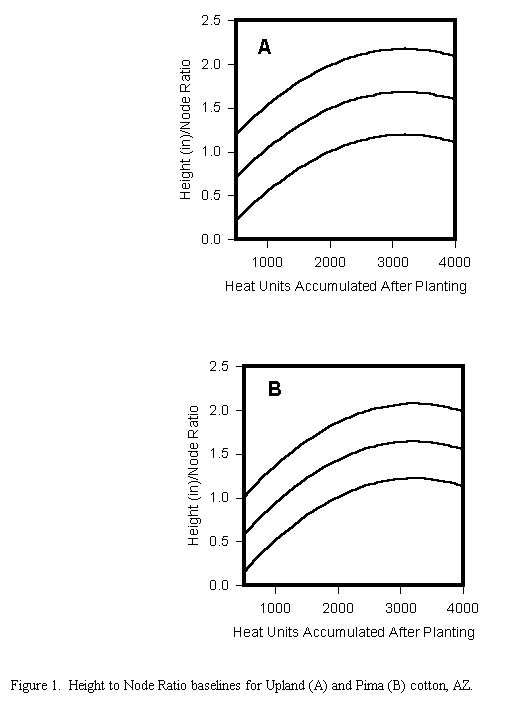Estimating the Vegetative/Reproductive Balance in Cotton Growth
(Publication az1218)
(PDF file version, 32KB)
by Jeffrey C. Silvertooth,
Extension Agronomist - Cotton
A healthy, well-developed cotton plant that is capable of high yield requires a strong root system, mainstem structure, sufficient leaves, and numerous fruiting branches to support a good boll load. Too small a vegetative structure on the plant results in reduced yield potential, and too much vegetative development, which is usually done at the expense of fruit set and yield. Accordingly, the central objective in a cotton production system is to provide a well-balanced level of development between the vegetative structure and the crop's fruit, hence the vegetative/reproductive balance. This balance is the object of many production strategies and many management decisions. Therefore, having some means of evaluating a crop with regard to this vegetative/reproductive balance is important to any cotton grower.
Any method of crop evaluation that is reliable is based upon some regular or systematic feature of the way the crop plant grows and develops. In the case of cotton, we have found several consistent and interesting factors that can be used for checking the crop. For example, we have found that mainstem nodes are produced at a fairly regular (linear) rate, when the plant is not subjected to significant stress (such as water stress). Therefore, the number of mainstem nodes (above the colytedons) is a good measure of crop (plant) age. For two crops of similar age, with one being more vegetative than the other, the plants should have a very similar number of mainstem nodes, but differ in the length of the internodes. In this case, the more vegetative crop would have the longer internodes and a taller structure. The factor we would commonly consider next is that regarding normal or acceptable ranges in internode length. As one might expect, this changes with crop age. A convenient way of expressing this on a relative scale is by the use of the height (inches): node ratio (HNR, Figure 1).
In review of Figure 1, the dark, central lines on each plot represent the baselines developed from several years of data collected at numerous locations in Arizona. The lighter lines above and below the baselines represent the upper and lower thresholds. Measurements taken which fall within these thresholds does not necessarily indicate an imbalance in crop development. However, significant departures from the baselines (beyond the thresholds) would warrant some reason for further, closer inspection of the crop.
If one were concerned about a crop's vegetative tendency, a simple count of mainstem nodes and plant height of several representative plants, would provide an easy estimate of the crop's vegetative/reproductive balance, with reference to an appropriate baseline (Figure 1). The use of a HNR offers a simple method of monitoring crop development. This type of information could be of value in crop management for inputs such as nitrogen fertilizer or plant growth regulator use, which are linked to crop development and fruit load.
Issued in furtherance of Cooperative Extension work, acts of May 8 and June 30, 1914, in cooperation with the U.S. Department of Agriculture, James A. Christenson, Director Cooperative Extension, College of Agriculture and Life Sciences, The University of Arizona.
The University of Arizona is an equal opportunity, affirmative action institution. The University does not discriminate on the basis of race, color, religion, sex, national origin, age, disability, veteran status, or sexual orientation in its programs and activities.
Any products, services, or organizations that are
mentioned, shown, or indirectly implied in this web document do not imply
endorsement by The University of Arizona.
Information provided by Jeffrey C. Silvertooth, silver@ag.arizona.edu
Extension Agronomist - Cotton, College of Agriculture, The University of Arizona.
Material written February 2001.
Crop Mgmt | Soil Mgmt | Irrigation | Varieties | Cotton Comments
Home | Cotton | Advisories
document located at: http://cals.arizona.edu/crops/cotton/cropmgt/veg_repro_balance.html
Copyright © 2001 University of Arizona,
College of Agriculture and Life Sciences
Webmaster: Al Fournier (acis@ag.arizona.edu)
